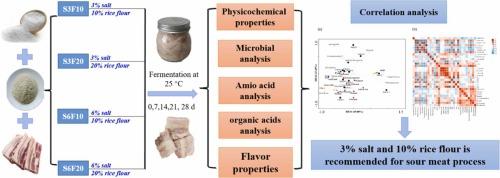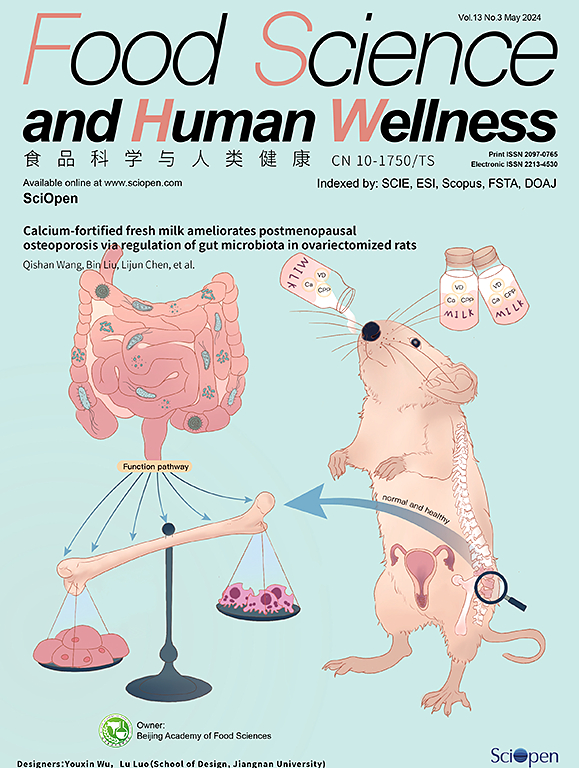盐和米粉浓度对中国传统肉类--酸肉的微生物多样性和质量的影响
IF 7.4
1区 农林科学
Q1 FOOD SCIENCE & TECHNOLOGY
引用次数: 0
摘要
本研究调查了在中国传统发酵肉类酸肉中添加盐(3 % 和 6 %,m/m)和米粉(10 % 和 20 %,m/m)的效果。研究发现,在自发发酵过程中,食盐的作用大于米粉。低盐组的 pH 值较低,可滴定总酸较高。低盐组的优势菌属是乳酸杆菌和乳球菌,而高盐组的优势菌属是葡萄球菌、魏氏菌和四源球菌。低盐组中游离氨基酸和必需氨基酸总量、有机酸、己酸乙酯和辛酸乙酯含量较高。RDA 分析表明,乳球菌与产品质量密切相关,S3F10(3 % 盐和 10 % 米粉)组在感官评价中优于其他组。因此,3 % 盐和 10 % 米粉被认为更适合用于生产健康美味的发酵酸肉。本文章由计算机程序翻译,如有差异,请以英文原文为准。

Effects of salt and rice flour concentration on microbial diversity and the quality of sour meat, a Chinese traditional meat
This study investigated the effects of salt (3 % and 6 %, m/m) and rice flour (10 % and 20 %, m/m) addition in sour meat, a traditional Chinese fermented meat. It was found that salt has greater effect than rice flour addition in spontaneous fermentation. Low-salt groups had lower pH and higher titratable total acid. In the low-salt groups, the dominant genera were Lactobacillus and Lactococcus, whereas Staphylococcus, Weissella, and Tetragenococcus were dominant in the high-salt groups. Higher total free amino acids and essential amino acids, organic acids, hexanoic acid ethyl ester and octanoic acid ethyl ester were found in the low-salt groups. The RDA analysis revealed that Lactococcus was closely related to product quality, with the S3F10 (3 % salt and 10 % rice flour) group outperforming the others in the sensory evaluation. Therefore, 3 % salt and 10 % rice flour were considered more appropriate for the production of healthy and tasty fermented sour meats.
求助全文
通过发布文献求助,成功后即可免费获取论文全文。
去求助
来源期刊

Food Science and Human Wellness
Agricultural and Biological Sciences-Food Science
CiteScore
8.30
自引率
5.70%
发文量
80
审稿时长
28 days
期刊介绍:
Food Science and Human Wellness is an international peer-reviewed journal that provides a forum for the dissemination of the latest scientific results in food science, nutriology, immunology and cross-field research. Articles must present information that is novel, has high impact and interest, and is of high scientific quality. By their effort, it has been developed to promote the public awareness on diet, advocate healthy diet, reduce the harm caused by unreasonable dietary habit, and directs healthy food development for food industrial producers.
 求助内容:
求助内容: 应助结果提醒方式:
应助结果提醒方式:


